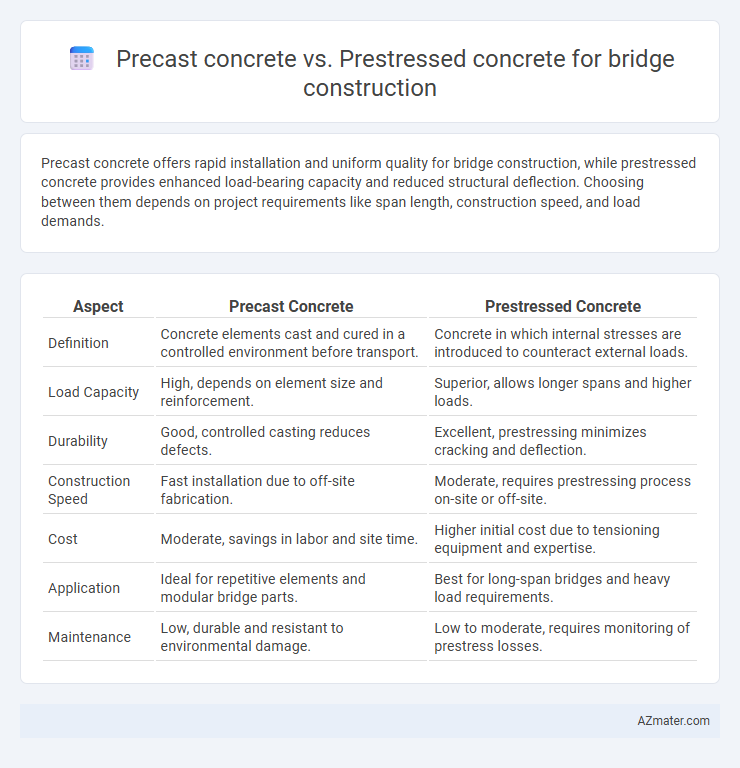Precast concrete offers rapid installation and uniform quality for bridge construction, while prestressed concrete provides enhanced load-bearing capacity and reduced structural deflection. Choosing between them depends on project requirements like span length, construction speed, and load demands.
Table of Comparison
| Aspect | Precast Concrete | Prestressed Concrete |
|---|---|---|
| Definition | Concrete elements cast and cured in a controlled environment before transport. | Concrete in which internal stresses are introduced to counteract external loads. |
| Load Capacity | High, depends on element size and reinforcement. | Superior, allows longer spans and higher loads. |
| Durability | Good, controlled casting reduces defects. | Excellent, prestressing minimizes cracking and deflection. |
| Construction Speed | Fast installation due to off-site fabrication. | Moderate, requires prestressing process on-site or off-site. |
| Cost | Moderate, savings in labor and site time. | Higher initial cost due to tensioning equipment and expertise. |
| Application | Ideal for repetitive elements and modular bridge parts. | Best for long-span bridges and heavy load requirements. |
| Maintenance | Low, durable and resistant to environmental damage. | Low to moderate, requires monitoring of prestress losses. |
Introduction to Precast and Prestressed Concrete
Precast concrete involves casting concrete elements in a controlled factory environment before transporting them to the construction site, ensuring high quality and rapid assembly. Prestressed concrete incorporates internal tensioned steel cables or tendons to enhance structural capacity, reducing cracking and increasing load-bearing efficiency. Both methods significantly improve durability and construction speed, making them essential in modern bridge engineering.
Key Differences Between Precast and Prestressed Concrete
Precast concrete involves casting concrete elements in a controlled factory environment before transporting them to the bridge site, providing high-quality and uniform components. Prestressed concrete embeds steel tendons under tension within the concrete to enhance its tensile strength and control cracking, allowing longer spans and heavier loads. While precast focuses on fabrication efficiency and consistency, prestressed concrete emphasizes structural performance and durability in bridge construction.
Material Composition and Manufacturing Process
Precast concrete for bridge construction is composed of a mixture of cement, aggregates, water, and admixtures, cast into molds and cured under controlled conditions to achieve high strength and durability. Prestressed concrete incorporates high-strength steel tendons tensioned before or after casting, enhancing load-bearing capacity and crack resistance by counteracting tensile forces. The manufacturing process of prestressed concrete involves precise tensioning techniques and tendon anchorage systems, resulting in components optimized for long-span bridges and heavy traffic loads.
Structural Properties and Load-Bearing Capacity
Precast concrete offers excellent modularity and uniform quality control, enhancing durability and reducing construction time, while prestressed concrete significantly improves tensile strength and minimizes cracking under heavy loads through internal tensioning of steel tendons. The load-bearing capacity of prestressed concrete bridges surpasses that of standard precast elements due to its ability to counteract tensile stresses, allowing for longer spans and slimmer profiles. Structural properties such as high compressive strength in precast concrete complement the enhanced flexural performance and fatigue resistance seen in prestressed concrete, making each suitable for specific bridge design requirements.
Installation Techniques and Construction Time
Precast concrete bridge components are manufactured off-site and assembled quickly on-site using cranes and connectors, significantly reducing construction time and minimizing traffic disruptions. Prestressed concrete requires careful tensioning of steel tendons before or after casting, which can extend installation times but allows for longer spans and reduced material use. Efficient installation of precast elements often leads to faster project completion, while prestressed concrete demands precise engineering and on-site tensioning, impacting overall construction scheduling.
Durability, Maintenance, and Lifespan
Precast concrete offers high durability due to factory-controlled manufacturing reducing defects and ensuring consistent quality, making it resistant to environmental factors and corrosion. Prestressed concrete enhances lifespan by introducing tensioning steel tendons that significantly improve load-carrying capacity and crack prevention, reducing maintenance requirements over time. Bridges constructed with prestressed concrete typically exhibit longer service life and lower life-cycle costs compared to traditional precast concrete due to superior structural performance and minimized deterioration.
Cost Comparison: Initial and Long-Term Expenses
Precast concrete offers lower initial costs due to standardized manufacturing and faster on-site assembly, reducing labor and construction time expenses. Prestressed concrete, while having higher upfront material and fabrication costs, provides enhanced durability and load-bearing capacity, leading to lower long-term maintenance and repair costs. Selecting between precast and prestressed concrete depends on balancing initial budget constraints with anticipated lifecycle savings and performance requirements.
Design Flexibility and Architectural Applications
Precast concrete offers significant design flexibility with customizable shapes, sizes, and finishes, allowing architects to create complex geometries and aesthetically appealing bridge components. Prestressed concrete enhances structural performance by enabling longer spans and thinner sections, which supports innovative architectural designs while maintaining durability and load-bearing capacity. Both materials are pivotal in contemporary bridge construction, balancing functional demands with creative architectural expressions.
Common Challenges and Solutions
Precast concrete in bridge construction often faces challenges such as joint durability and transportation constraints, while prestressed concrete struggles with tension loss and complex manufacturing processes. Solutions for precast concrete include advanced joint sealing techniques and modular transport logistics, whereas prestressed concrete benefits from improved cable anchorage designs and precise tension monitoring systems. Both methods require rigorous quality control and site coordination to ensure structural integrity and longevity.
Choosing the Right Concrete Method for Bridge Construction
Choosing the right concrete method for bridge construction depends on factors such as load requirements, span length, and construction speed. Precast concrete offers high quality control and faster installation due to factory fabrication, making it suitable for repetitive or modular bridge elements. Prestressed concrete provides enhanced tensile strength and improved durability, ideal for longer spans and heavier loads where minimizing deflection and cracking is critical.

Infographic: Precast concrete vs Prestressed concrete for Bridge construction
 azmater.com
azmater.com